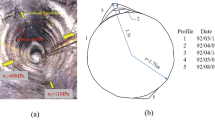Abstract
The geometrical complexity of the fracture space in a rock mass makes the study of the seepage characteristics of fractured rock masses very challenging. Therefore, the study of size effect of fracture intersections, which is the basic fracture shape of fractured rock, can guide the research of fracture seepage. In this context, this paper used FLUENT software to perform a two-dimensional numerical analysis of seepage characteristics at fracture intersection of nine different sizes and analyzed the effect of the intersection size on the fluid pattern and its fractal dimension and split-flow characteristics. The results show that, on the whole, the fractal dimension of the fluid pattern first increased and then decreased, then increased and decreased again with the flow of fluid. The critical point that determined whether fluid would flow out of horizontal fractures was a/b = 0.15; beyond this value, fluid would flow out of three pressure outlets, with flow out of horizontal fractures being higher than out of longitudinal fractures. a/b = 7 was the critical point that determined whether fluid would flow out of longitudinal fractures; at greater values, fluid would flow out of both horizontal fractures and would be far greater than longitudinal flow.









Similar content being viewed by others
References
Dragila MI, Weisbrod N (2004) Fluid motion through an unsaturated fracture junction. Water Resour Res 40(2):389–391
Hossain MS, Kruhl JH (2015) Fractal geometry-based quantification of shock-induced rock fragmentation in and around an impact crater. Pure appl Geophys 172(7):2009–2023
Huang WP, Li C, Zhang LW et al (2018) In situ identification of water-permeable fractured zone in overlying composite strata. Int J Rock Mech Min Sci 105:85–97
Jeong W, Song J (2005) Numerical investigations for flow and transport in a rough fracture with a hydromechanical effect. Energy Sources 27(11):997–1011
Ji SH, Nicholl MJ, Glass RJ, Lee KK (2006) Influence of simple fracture intersections with differing aperture on density-driven immiscible flow: wetting versus nonwetting flows. Water Resour Res 42(10):730–732
Johnson J, Brown S, Stockman H (2006) Fluid flow and mixing in rough-walled fracture intersections. J Geophys Res Solid Earth 111(B12):B12206
Kaiser N, Cröll A, Szofran FR et al (2001) Wetting angle and surface tension of germanium melts on different substrate materials. J Cryst Growth 231(4):448–457
Koyama T, Li B, Jiang YJ et al (2008) Numerical simulations for the effects of normal loading on particle transport in rock fractures during shear. Int J Rock Mech Min Sci 45(8):1403–1419
Lainé S, Phan L, Pellarin P et al (1999) Operating diagnostics on a flocculator-settling tank using fluent cfd software. Water Sci Technol 39(4):155–162
Li J, Du Q, Sun C (2009) An improved box-counting method for image fractal dimension estimation. Pattern Recogn 42(11):2460–2469
Liu R, Jiang YJ, Li B (2016) Effects of intersection and dead-end of fractures on nonlinear flow and particle transport in rock fracture networks. Geosci J 20(3):415–426
Liu R, Li B, Jiang YJ (2018) A numerical approach for assessing effects of shear on equivalent permeability and nonlinear flow characteristics of 2-D fracture networks. Adv Water Resour 111:289–300
Shi L, Singh RN (2001) Study of mine water inrush from floor strata through faults. Mine Water Environ 20(3):140–147
Tsang YW, Tsang CF, Neretnieks I et al (1988) Flow and tracer transport in fractured media: a variable aperture channel model and its properties. Water Resour Res 24(12):2049–2060
Volland S, Kruhl JH (2004) Anisotropy quantification: the application of fractal geometry methods on tectonic fracture patterns of a Hercynian fault zone in NW Sardinia. J Struct Geol 26(8):1499–1510
Walton KM, Unger AJA, Ioannidis MA et al (2017) Impact of eliminating fracture intersection nodes in multiphase compositional flow simulation. Water Resour Res 53:2917–2939. https://doi.org/10.1002/2016wr020088
Wang X, Meng FB (2018) Statistical analysis oflarge accidents in China’s coal mines in 2016. Nat Hazards 92(1):311–325
Watkins DJ (2013) Acquisition and preparation of specimens of rock for large-scale testing. Geophys Res Lett 8(7):679–682
Wood TR, Nicholl MJ, Glass RJ (2005) Influence of fracture intersections under unsaturated, low-flow conditions. Water Resour Res 410(4):1517–1523
Wu Q (2014) Progress, problems and prospects of prevention and control technology of mine water and reutilization in China. J China Coal Soc 39(5):795–805
Wu Q, Dong S, Li B et al (2018) Mine water inrush. Springer, New York
Acknowledgements
This work was supported by the National Key Research and Development Program (Grant No. 2016YFC0600901).
Author information
Authors and Affiliations
Corresponding author
Additional information
Publisher's Note
Springer Nature remains neutral with regard to jurisdictional claims in published maps and institutional affiliations.
Rights and permissions
About this article
Cite this article
Chun, Z., Yuan, C., Xuebin, C. et al. Study on the Size Effect of Fracture Intersections Based on the Fractal Theory. Geotech Geol Eng 37, 2999–3006 (2019). https://doi.org/10.1007/s10706-019-00818-z
Received:
Accepted:
Published:
Issue Date:
DOI: https://doi.org/10.1007/s10706-019-00818-z




